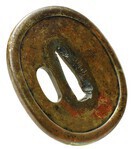Cris -
Morita-san has already answered your question. To fill it out a bit;
Omote 1満2鐵3鍛5之(wo)4造 or Mantetsu kitae kore(wo)tsukuru (made this using Mantetsu forging)
Ura 1昭2和3甲4申(doshi) 5春 or Showa Kinoe-saru (doshi) Haru
(Spring, year of the elder brother of the wood-monkey in the Showa era)
This is a rather unusual signature, not rare but not ordered in the way the signature of most individual smiths would be. Showa era signatures are tough to work with since there tends to be more use of Chinese order in the kanji (Kanbun) and zodiacal (?) dating as in this example.
If you are interested in learning to translate signatures it is not that difficult; remember that the last two kanji are usually the smiths name - if the last kanji is saku (or tsukuru) then the two above that are the name - learn to recognize common kanji like kuni, kami, fujiwara and ju - these can be used as landmarks like saku and you can often work the rest out from there.
Best of luck with your studies,
-t



